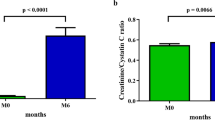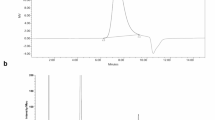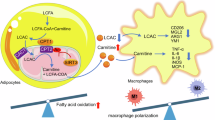Abstract
Introduction
The current obesity crisis has resulted in many people with excess adipose tissue suffering from chronic inflammation. This inflammation is largely due to the release of cytokines and chemokines from visceral fat. The aim of this study was to identify potential anti-inflammatory agents that might alleviate obesity-induced chronic inflammation.
Methods
To identify agents that might alleviate this obesity-induced chronic inflammation we have developed a simple protocol for incubating intact pieces of human visceral adipose tissue in 35 mm tissue culture plates, in the presence of low-dose lipopolysaccharide (LPS) and co-incubating these samples with potential anti-inflammatory agents. RNA-Seq analysis was performed to identify enriched gene expression signatures among the most significantly differentially expressed genes.
Results
From this screen, we have identified the short-chain fatty acid (SCFA) sodium butyrate and its triacylglyceride form, tributyrin, as effective agents, significantly reducing the production of LPS-induced inflammatory cytokines and chemokines from all adipose tissue samples tested. As well, these agents appear to be non-toxic at the concentrations tested. RNA-Seq analysis has revealed that IL36γ is one of the most upregulated genes in response to LPS and one of the most downregulated when sodium butyrate is added to human fat samples stimulated with LPS. IL-36γ ELISAs confirmed this holds true at the protein level as well.
Conclusions
These studies suggest that the short-chain fatty acid, sodium butyrate, and its triacylglyceride form, tributyrin, might alleviate the chronic inflammation that is associated with many individuals with obesity.
This is a preview of subscription content, access via your institution
Access options
Subscribe to this journal
Receive 12 print issues and online access
$259.00 per year
only $21.58 per issue
Buy this article
- Purchase on SpringerLink
- Instant access to full article PDF
Prices may be subject to local taxes which are calculated during checkout





Similar content being viewed by others
Data availability
All data relevant to the study are included in the article.
References
Huttunen R, Syrjanen J. Obesity and the risk and outcome of infection. Int J Obes. 2013;37:333–40.
Honce R, Schultz-Cherry S. Impact of obesity on influenza A virus pathogenesis, immune response, and evolution. Front Immunol. 2019;10:1071.
Deng T, Lyon CJ, Bergin S, Caligiuri MA, Hsueh WA. Obesity, inflammation, and cancer. Annu Rev Pathol. 2016;11:421–49.
Lee H. Obesity-associated cancers: evidence from studies in mouse models. Cells. 2022;11:1472.
Barton JR, Snook AE, Waldman SA. From leptin to lasers: the past and present of mouse models of obesity. Expert Opin Drug Discov. 2021;16:777–90.
Rana MN, Neeland IJ. Adipose tissue inflammation and cardiovascular disease: an update. Curr Diab Rep. 2022;22:27–37.
Atkuri KR, Herzenberg LA, Niemi AK, Cowan T, Herzenberg LA. Importance of culturing primary lymphocytes at physiological oxygen levels. Proc Natl Acad Sci USA. 2007;104:4547–52.
Wu D, Han JM, Yu X, Lam AJ, Hoeppli RE, Pesenacker AM, et al. Characterization of regulatory T cells in obese omental adipose tissue in humans. Eur J Immunol. 2019;49:336–47.
Carswell KA, Lee MJ, Fried SK. Culture of isolated human adipocytes and isolated adipose tissue. Methods Mol Biol. 2012;806:203–14.
Dobin A, Davis CA, Schlesinger F, Drenkow J, Zaleski C, Jha S, et al. STAR: ultrafast universal RNA-seq aligner. Bioinformatics. 2013;29:15–21.
Robinson MD, McCarthy DJ, Smyth GK. edgeR: a Bioconductor package for differential expression analysis of digital gene expression data. Bioinformatics. 2010;26:139–40.
Ritchie ME, Phipson B, Wu D, Hu Y, Law CW, Shi W, et al. limma powers differential expression analyses for RNA-sequencing and microarray studies. Nucleic Acids Res. 2015;43:e47.
Yu G, Wang LG, Han Y, He QY. clusterProfiler: an R package for comparing biological themes among gene clusters. Omics. 2012;16:284–7.
Kolb H. Obese visceral fat tissue inflammation: from protective to detrimental? BMC Med. 2022;20:494.
Višnjić D, Lalić H, Dembitz V, Tomić B, Smoljo T. AICAr, a widely used AMPK activator with important AMPK-independent effects: a systematic review. Cells. 2021;10:1095.
Elisia I, Lam V, Cho B, Hay M, Li MY, Kapeluto J, et al. Exploratory examination of inflammation state, immune response and blood cell composition in a human obese cohort to identify potential markers predicting cancer risk. PLoS ONE. 2020;15:e0228633.
Zatterale F, Longo M, Naderi J, Raciti GA, Desiderio A, Miele C, et al. Chronic adipose tissue inflammation linking obesity to insulin resistance and type 2 diabetes. Front Physiol. 2020;10:1607.
Kawai T, Autieri MV, Scalia R. Adipose tissue inflammation and metabolic dysfunction in obesity. Am J Physiol Cell Physiol. 2021;320:C375–91.
Weisberg SP, McCann D, Desai M, Rosenbaum M, Leibel RL, Ferrante AW Jr. Obesity is associated with macrophage accumulation in adipose tissue. J Clin Invest. 2003;112:1796–808.
Shuster A, Patlas M, Pinthus JH, Mourtzakis M. The clinical importance of visceral adiposity: a critical review of methods for visceral adipose tissue analysis. Br J Radio. 2012;85:1–10.
Saltiel AR, Olefsky JM. Inflammatory mechanisms linking obesity and metabolic disease. J Clin Invest. 2017;127:1–4.
van Galen KA, Schrantee A, ter Horst KW, la Fleur SE, Booij J, Constable RT, et al. Brain responses to nutrients are severely impaired and not reversed by weight loss in humans with obesity: a randomized crossover study. Nat Metab. 2023;5:1059–72.
Hall KD, Kahan S. Maintenance of lost weight and long-term management of obesity. Med Clin North Am. 2018;102:183–97.
van Deuren T, Blaak EE, Canfora EE. Butyrate to combat obesity and obesity-associated metabolic disorders: current status and future implications for therapeutic use. Obes Rev. 2022;23:e13498.
Elisia I, Krystal G. The pros and cons of low carbohydrate and ketogenic diets in the prevention and treatment of cancer. Front Nutr. 2021;8:634845.
Frühbeck G, Gómez-Ambrosi J, Ramírez B, Mentxaka A, Rodríguez A, Becerril S, et al. Increased levels of interleukin-36 in obesity and type 2 diabetes fuel adipose tissue inflammation by inducing its own expression and release by adipocytes and macrophages. Front Immunol. 2022;13:832185.
Elisia I, Pae HB, Lam V, Cederberg R, Hofs E, Krystal G. Comparison of RAW264.7, human whole blood and PBMC assays to screen for immunomodulators. J Immunol Methods. 2018;452:26–31.
Guo L-T, Wang S-Q, Su J, Xu L-X, Ji Z-Y, Zhang R-Y, et al. Baicalin ameliorates neuroinflammation-induced depressive-like behavior through inhibition of toll-like receptor 4 expression via the PI3K/AKT/FoxO1 pathway. J Neuroinflammation. 2019;16:95.
Amini R, Yazdanparast R, Ghaffari SH. Apigenin modulates the expression levels of pro-inflammatory mediators to reduce the human insulin amyloid-induced oxidant damages in SK-N-MC cells. Hum Exp Toxicol. 2014;34:642–53.
Sakai C, Ishida M, Ohba H, Yamashita H, Uchida H, Yoshizumi M, et al. Fish oil omega-3 polyunsaturated fatty acids attenuate oxidative stress-induced DNA damage in vascular endothelial cells. PLoS ONE. 2017;12:e0187934.
Ayasolla KR, Singh AK, Singh I. 5-aminoimidazole-4-carboxamide-1-beta-4-ribofuranoside (AICAR) attenuates the expression of LPS- and Abeta peptide-induced inflammatory mediators in astroglia. J Neuroinflammation. 2005;2:21.
Kim M, Nowakowski M, Joks R. Effects of curcumin on LPS-induced nitric oxide production from murine macrophages and PBMC of humans with respiratory allergic disease. J Allergy Clin Immunol. 2011;127:AB261.
LaMoia TE, Shulman GI. Cellular and molecular mechanisms of metformin action. Endocr Rev. 2020;42:77–96.
Hoppe J, Schäfer R, Hoppe V, Sachinidis A. ATP and adenosine prevent via different pathways the activation of caspases in apoptotic AKR-2B fibroblasts. Cell Death Differ. 1999;6:546–56.
Rafiei H, Yeung M, Kowalski S, Krystal G, Elisia I. Development of a novel human triculture model of non-alcoholic fatty liver disease and identification of berberine as ameliorating steatosis, oxidative stress and fibrosis. Front Pharmacol. 2023;14:1234300.
Elisia I, Kitts DD. Different tocopherol isoforms vary in capacity to scavenge free radicals, prevent inflammatory response, and induce apoptosis in both adult- and fetal-derived intestinal epithelial cells. Biofactors. 2013;39:663–71.
Elisia I, Kitts DD. Tocopherol isoforms (alpha-, gamma-, and delta-) show distinct capacities to control Nrf-2 and NfκB signaling pathways that modulate inflammatory response in Caco-2 intestinal cells. Mol Cell Biochem. 2015;404:123–31.
Elisia I, Kitts DD. Modulation of NF-κB and Nrf2 control of inflammatory responses in FHs 74 Int cell line is tocopherol isoform-specific. Am J Physiol Gastrointest Liver Physiol. 2013;305:G940–9.
Kieronska-Rudek A, Kij A, Kaczara P, Tworzydlo A, Napiorkowski M, Sidoryk K. et al. Exogenous vitamins K exert anti-inflammatory effects dissociated from their role as substrates for synthesis of endogenous MK-4 in murine macrophages cell line. Cells. 2021;10:1571.
Tuohimaa P, Golovko O, Kalueff A, Nazarova N, Qiao S, Syvälä H, et al. Calcidiol and prostate cancer. J Steroid Biochem Mol Biol. 2005;93:183–90.
Wang J, Guo S, Xu X, Zhang C. 1,25-Dihydroxyvitamin D3: a positive factor for the osteogenic differentiation of hPDLSCs and for the tissue regenerative activity of cell sheets. Cell Transpl. 2023;32:09636897231202541.
Thai PN, Miller CV, King MT, Schaefer S, Veech RL, Chiamvimonvat N, et al. Ketone ester D‐β‐hydroxybutyrate‐(R)‐1,3 butanediol prevents decline in cardiac function in type 2 diabetic mice. J Am Heart Assoc. 2021;10:e020729.
Mazurek S, Michel A, Eigenbrodt E. Effect of extracellular AMP on cell proliferation and metabolism of breast cancer cell lines with high and low glycolytic rates. J Biol Chem. 1997;272:4941–52.
Adzic M, Stevanovic I, Josipovic N, Laketa D, Lavrnja I, Bjelobaba IM, et al. Extracellular ATP induces graded reactive response of astrocytes and strengthens their antioxidative defense in vitro. J Neurosci Res. 2017;95:1053–66.
Hidalgo M, Martin-Santamaria S, Recio I, Sanchez-Moreno C, de Pascual-Teresa B, Rimbach G, et al. Potential anti-inflammatory, anti-adhesive, anti/estrogenic, and angiotensin-converting enzyme inhibitory activities of anthocyanins and their gut metabolites. Genes Nutr. 2012;7:295–306.
Winter AN, Brenner MC, Punessen N, Snodgrass M, Byars C, Arora Y, et al. Comparison of the neuroprotective and anti-inflammatory effects of the anthocyanin metabolites, protocatechuic acid and 4-hydroxybenzoic acid. Oxid Med Cell Longev. 2017;2017:6297080.
Walker J, Schueller K, Schaefer L-M, Pignitter M, Esefelder L, Somoza V. Resveratrol and its metabolites inhibit pro-inflammatory effects of lipopolysaccharides in U-937 macrophages in plasma-representative concentrations. Food Func. 2014;5:74–84.
Kondreddy VKR, Kamatham AN. Celecoxib, a COX-2 inhibitor, synergistically potentiates the anti-inflammatory activity of docosahexaenoic acid in macrophage cell line. Immunopharmacol Immunotoxicol. 2016;38:153–61.
Kawase T, Orikasa M, Suzuki A. Effects of prostaglandin E2 and F2α on cytoplasmic pH in a clonal osteoblast-like cell line, MOB 3–4. J Cell Phys. 1991;146:141–7.
Chen Q, Ross AC. Retinoic acid regulates cell cycle progression and cell differentiation in human monocytic THP-1 cells. Exp Cell Res. 2004;297:68–81.
Acknowledgements
The research was supported by the Lotte and John Hecht Memorial Foundation (#3693), with core support from the BC Cancer Foundation and BC Cancer. This study was in part supported by Program Project Grant funding from the Terry Fox Research Institute (Grant No. 1108 to CS). MYL is a PhD candidate at the University of British Columbia, Canada, and is supported by an Elizabeth C. Watters Research Fellowship.
Author information
Authors and Affiliations
Contributions
IE, GK, and HR conceptualized the study; IE, HR, MY, SK, MYL, SH, and LB performed experiments; IE, HR, MY, SK, SH, and GD analyzed data and figures; IE, MYL, GD, and GK wrote the first draft; IE, HR, MY, MYL, GD, DH, CS, and GK reviewed and revised the manuscript; NN, EY, and SS performed the bariatric surgeries; DH, JC, CS, and GK provided resources and supervision; all authors have read and agreed to the final version of the manuscript.
Corresponding author
Ethics declarations
Competing interests
CS has performed consultancy for Bayer and Eisai, and has received research funding from Epizyme and Trillium Therapeutics.
Additional information
Publisher’s note Springer Nature remains neutral with regard to jurisdictional claims in published maps and institutional affiliations.
Supplementary information
Rights and permissions
Springer Nature or its licensor (e.g. a society or other partner) holds exclusive rights to this article under a publishing agreement with the author(s) or other rightsholder(s); author self-archiving of the accepted manuscript version of this article is solely governed by the terms of such publishing agreement and applicable law.
About this article
Cite this article
Rafiei, H., Yeung, M., Kowalski, S. et al. Butyrate and tributyrin reduce LPS-induced inflammatory cytokine production from human visceral fat. Int J Obes 48, 1559–1567 (2024). https://doi.org/10.1038/s41366-024-01581-9
Received:
Revised:
Accepted:
Published:
Issue date:
DOI: https://doi.org/10.1038/s41366-024-01581-9



